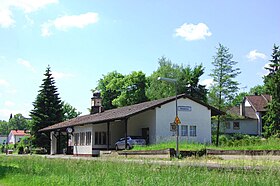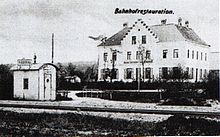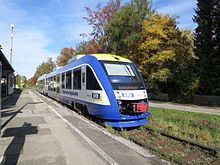Riederau train station
| Riederau | |
|---|---|
|
Riederau train station from the northeast
|
|
| Data | |
| Operating point type | Stopping point with cover point |
| Platform tracks | 1 |
| abbreviation | MRDU |
| IBNR | 8005086 |
| Price range | 7th |
| opening | December 23, 1898 |
| Website URL | Stationsdatenbank.de |
| Architectural data | |
| Architectural style | Home style |
| location | |
| City / municipality | Dießen am Ammersee |
| Place / district | Riederau |
| country | Bavaria |
| Country | Germany |
| Coordinates | 47 ° 58 '57 " N , 11 ° 5' 50" E |
| Railway lines | |
|
|
| Railway stations in Bavaria | |
The Riederau train station is a former train station and is now a stop in the Riederau district of the Upper Bavarian community of Dießen am Ammersee . It is located on the Ammerseebahn from Mering via Geltendorf to Weilheim . The station has a platform track and belongs to station category 7 of DB Station & Service . Around 50 trains of the Bayerische Regiobahn (BRB) stop in Riederau every day .
The Riederau station was opened on December 23, 1898 together with the Ammerseebahn. In 1976 the station was downgraded from the train station to the stopping point. Built in 1938, the reception building is under monument protection . In addition to the Riederau station, there is also the Dießen station and the St. Alban stop in Dießen am Ammersee .
location
The Riederau train station is located in the east of Riederau about four kilometers north of the center of Dießen am Ammersee. It is located about 150 meters from the shore of the Ammersee . The station building is to the west of the track at Bahnhofplatz and has the address Bahnhofstraße 1. South of the building is State Road 2055 from Schondorf to Dießen. To the south of the stop is a level crossing that connects the state road and the center of Riederau with the lake shore.
The Ammerseebahn from Mering via Geltendorf to Weilheim ( VzG 5370), where the train station is located, is a single-track and non-electrified main line . It is run by Deutsche Bahn as the route book 985 Augsburg –Weilheim.
history
As early as the 1870s there were first plans to build a railway line from Augsburg via Mering to the west bank of the Ammersee and on towards the Alps . In 1886 the planning of a local railway from Mering via Schondorf to Dießen was approved. In the preliminary planning, there was no stop in Riederau, as the place then consisted of only a few houses. However, since the profitability of timber loading was recognized, the Augsburg Railway Construction Committee planned an additional station in Riederau. In the autumn of 1896, the railway construction committee began building the line from Mering to Weilheim, known as the Ammerseebahn.
On June 30, 1898, the Royal Bavarian State Railways opened the sections from Mering to Schondorf and from Dießen to Weilheim. Alternatively, ships ran across the Ammersee between Schondorf and Dießen. It was not until December 23, 1898 that the gap was closed and the Utting and Riederau through stations opened . Initially, only a corrugated iron hut served as a reception building at Riederau station . Across from the corrugated iron hut, a large railway station restoration was carried out in 1902 on today's Seiboldstrasse (Staatsstrasse 2055). In 1903 the station was given a wooden barrack as a reception building, which had previously stood at the Dießen station and was replaced there in 1902 by a brick building. A goods shed with a loading ramp was connected to the building to the north . Due to the station, the previously very small town of Riederau grew strongly and today has over 1000 inhabitants. Riederau was an important station in timber loading and contributed to the Ammerseebahn being elevated to the status of the main line in 1913 .
In 1937, the Deutsche Reichsbahn had a brick entrance building with a gable roof , an open waiting hall and an adjoining goods shed built. The wooden barracks and the old goods shed were demolished. Only the old loading ramp remained.
In 1975 the old station restoration, which was no longer needed due to the falling traffic, was canceled. In 1976 the Deutsche Bundesbahn closed the loading track . As a result, the station became a stop with a block . In 1983 the disused loading track was dismantled. After the DB shut down Greifenberg station in 1984 , consideration was given to shutting down the Riederau stop. In order to end the occupation of the stop, the DB planned an electrical barrier at the level crossing south of the stop, which should replace the previous mechanical barrier system operated by a barrier winch. Due to the proximity of the station to the Ammersee and the resulting importance in excursion traffic, the traffic stop was retained and the reception building was still occupied.
In August 1999, Deutsche Bahn put a ticket machine into operation in the open waiting hall. The ticket office was originally scheduled to close on November 1, 2001, but sales did not stop completely until early 2002.
On May 25, 1997, a local newspaper reported that the station was becoming overgrown, despite the station's importance in excursion traffic. On June 16, 2002, the Riederau Beautification Association decided, in consultation with Deutsche Bahn, to improve the appearance. In December 2003 the association was able to complete the restoration of the clock tower. With the commissioning of the new electronic interlocking in the Dießen train station in November 2009, from an operational perspective, the former Riederau block post became the Riederau cover point . On January 1, 2013, the community of Dießen took over the station building from Deutsche Bahn for a purchase price of 35,000 euros.
construction
Reception building
The listed entrance building of the Riederau train station was opened in 1938. Its construction is similar to the reception building of the St. Ottilien train station . The single-storey brick building in the Heimat style consists of a main building with a waiting room and service rooms, a half-open waiting hall in the south and a goods shed to the north. The main building, waiting hall and goods shed are covered by an eaves gable roof. On the roof there is a clock tower designed as a ridge turret with an onion dome covered with wooden shingles . It has a clock on all four sides and is decorated with signs of the zodiac . After the clock and decorative paintings were temporarily plastered over, they have been available again since the restoration in December 2003. The half-open waiting hall is made of an open wooden beam construction. On the inside gable of the waiting hall there is a mural showing children bathing on the Ammerseestrand. A second painting on the south side of the building, on which two fishermen in the boat could be seen, was plastered over during renovation work and is therefore no longer available. The wooden platform barriers that separate the waiting hall from the platform are still completely intact, but are now permanently open.
On the track side of the building, under the saddle roof, there is an interlocking front building in which there is a mechanical interlocking that is still occupied today . It is now only used to position the main signals that serve as cover signals. Until 1976 it was also responsible for setting the points for the loading track. The barrier winch for operating the level crossing in the south of the stopping point, which is mechanically operated by rope hoists, is located outside the signal box front structure on the platform. The signal box's tensioning system is housed in the 3.50 meter high basement .
There is a ticket office in the closed waiting room, which was closed in early 2002. Originally, the baggage claim area was also integrated into the waiting room with a roller shutter. The waiting room is still open today.
Track systems
The track systems of the Riederau train station consisted of the continuous main track on the house platform and a loading track with a loading ramp that could be used from the direction of Dießen. In 1976 the no longer required loading track was shut down and dismantled in 1983. The pre-war loading ramp has been preserved to this day. The length of the platform was adapted to today's traffic requirements in the 2000s and shortened by about a third using information boards. The house platform has been 126 meters long and 22 centimeters high since then. Of the original four main station shape signals , the two former entry signals from the direction of Utting and Dießen are still there . Since the block section was closed in 2009, they have only served as cover signals for the level crossing.
traffic
passenger traffic
From December 24, 1898, through passenger trains between Mering and Weilheim stopped at Riederau station. Riederau was served by all passenger trains, while the express trains running from 1913 passed through the station. In 1914 five passenger trains stopped daily from Augsburg to Weilheim and one from Geltendorf to Weilheim. The volume of traffic, which fell during the Second World War and the post-war period, rose again in the 1950s. In 1955 nine passenger trains drove from Augsburg to Weilheim and one from Geltendorf to Weilheim. On weekends, the DB used an additional bathing train from Augsburg to Dießen for excursions to the Ammersee. In the following years the number of trains remained largely constant. As a result of rationalization, the DB replaced many local trains with express trains in the 1980s . In 1990, only four local trains stopped in Riederau. With the Werdenfels cycle , Deutsche Bahn introduced the hourly cycle on the Ammerseebahn for the 1995 summer timetable .
Today all trains on the Ammerseebahn stop at the Riederau stop. Since December 14, 2008, trains of the Bayerische Regiobahn (BRB) have been running every hour from Augsburg-Oberhausen to Schongau , which are driven by LINT 41 diesel multiple units . During rush hour , the BRB uses additional repeater trains from Geltendorf to Peißenberg every hour, which run every half hour on this section.
Freight transport
The Riederau station was of great importance in freight traffic. Mainly wood from the Dettenhofer forest was loaded at the loading ramp. The timber loading contributed an important part to the freight traffic on the Ammerseebahn. In addition, the local loading facility was used to load agricultural products and cattle. For this purpose, the DB served the station in local freight traffic until the 1960s with a “collector” who delivered or picked up cars at all stations along the route. In the 1960s and 1970s, freight traffic steadily decreased and was finally stopped completely. In 1976 the loading track was closed.
See also
literature
- Andreas Janikowski: The Ammerseebahn. Traffic development in western Upper Bavaria . Transpress, Stuttgart 1996, ISBN 3-344-71033-8 .
- Peter Rasch: The branch lines between Ammersee, Lech and Wertach. With the Ammerseebahn, Pfaffenwinkelbahn & Co around the Bavarian Rigi . EOS Verlag, St. Ottilien 2011, ISBN 978-3-8306-7455-9 .
Web links
- Description of the Riederau train station on ammerseebahn.de.
- Photo documentation of the Riederau train station on doku-des-alltags.de.
Individual evidence
- ↑ Abbreviations of the operating points on michaeldittrich.de, accessed on January 14, 2017.
- ↑ a b List of monuments for Dießen am Ammersee (PDF) at the Bavarian State Office for Monument Preservation, accessed on March 31, 2018.
- ↑ Query of the course book route 985 at Deutsche Bahn.
- ↑ Janikowski: The Ammerseebahn . 1996, p. 13-14 .
- ^ Rasch: The branch lines between Ammersee, Lech and Wertach . 2011, p. 135-136 .
- ^ A b c Janikowski: The Ammerseebahn . 1996, p. 59-60 .
- ↑ a b Alwin Reiter: Description of the Riederau train station on ammerseebahn.de, accessed on March 31, 2018.
- ↑ Ursula Nagl: Station number two - market community now also calls the Riederau station its own , from the Kreisbote , from January 16, 2013, accessed on March 31, 2018.
- ↑ Holger Kötting: List of German signal boxes on stellwerke.de, accessed on October 5, 2013.
- ^ Rasch: The branch lines between Ammersee, Lech and Wertach . 2011, p. 136 .
- ↑ Deutsche Bahn: Riederau station equipment ( Memento of the original from April 1, 2018 in the Internet Archive ) Info: The archive link has been inserted automatically and has not yet been checked. Please check the original and archive link according to the instructions and then remove this notice. on deutschebahn.com, March 1, 2018, accessed on March 31, 2018.
- ↑ Janikowski: The Ammerseebahn . 1996, p. 94 .
- ↑ Janikowski: The Ammerseebahn . 1996, p. 93 .
- ↑ Janikowski: The Ammerseebahn . 1996, p. 97-100 .
- ^ Rasch: The branch lines between Ammersee, Lech and Wertach . 2011, p. 137 .





